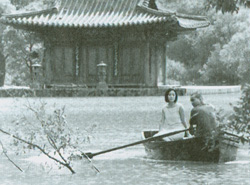Spring, Summer, Fall, Winter . . . And Spring
Kim Ki-Duk, Director
Sony Pictures Classics, 2003
102 minutes
Early in Spring, Summer, Fall, Winter . . . and Spring, the dreamlike new film by Korean director Kim Ki-duk, a young boy is seen playing with a fish, a frog, and a snake. An apprentice monk, he lives with his Buddhist master in a tiny temple floating on a raft in the middle of a lake. When the older monk discovers his charge gleefully tying stones to the animals, he admonishes the boy: “If any of them are dead, you will carry the stone in your heart forever.” As the film progresses, the weight of those words drowns several lives—some figuratively, some literally.
Unfolding in five distinct acts—one for each season in the title—Spring, Summer, Fall, Winter . . . and Spring is epic in scale, yet the action is confined to just a few acres. It is a micro-world of astonishing beauty, in which doors stand in places where there are no walls—reminding us how fragile the boundary is between the sacred and the profane. There are only six characters in the film, but the passage of time and the power of nature have costarring roles in virtually every scene.

It is spring when we first meet the protagonist, and the camera invites us to spy on his childish cruelty to the animals. (Snakes, a recurring image, traditionally symbolize aversion, one of the three poisons according to Buddhist teachings; in this film they more often connote attachment.)
In the next act—summer, a few years later—the boy, now an adolescent, is startled by the sudden appearance of two women, a mother and daughter, the first visitors to his hermetic world. The daughter seeks healing from the Buddhist master for an unnamed malady; with her arrival, the young man experiences the first intimations of sexual awakening. After the mother leaves, the two teens become lovers, but the boy’s passion quickly turns to obsession. “Lust awakens the desire to possess, and that awakens the desire to murder,” the master says, as he sends away the girl, apparently now healed.
Heartbroken, the youth steals the Buddha from his master’s altar, jumps in their boat, and rows off. In one of the movie’s most powerful and understated moments, the master awakens and, without a hint of emotion, sits down to meditate before the shadow image of the Buddha on the wall behind the spot where the statue had stood.
In the third act, fall, the master (now aged considerably) returns home with provisions wrapped in newspaper. As he opens the parcel, he notices a headline: MAN, 30, FLEES AFTER MURDERINGWIFE. Soon thereafter, the young man returns carrying the Buddha statue and a bloody knife, and reveals that his wife had cheated on him. “Sometimes we have to let go of things we like,” is the master’s stoic reply.
After beating his student brutally, the master, in a wryly humorous scene, begins to write theHeart Sutra on the temple deck, using his cat’s tail as a calligraphy brush. When he finishes, he commands the young man: “Carve out all of these characters, and while you are carving, anger will be cut out of your heart.”
But his purification is interrupted when plainclothes detectives arrive. They are persuaded by the master to wait, while the young man carves through the night. In a surreal demonstration of compassion, one of the detectives holds a candle for the young man, then both help him paint the characters in bright colors. This is about as far from an Arnold Schwarzenegger action thriller as one could get, and the subtlety is refreshing, though the message is somewhat muddled: Has the transforming power of the Heart Sutra affected both cops and criminal? Has the murderer’s negative karma been purified before our eyes?
Finally, the Heart Sutra is inscribed, and it is time for the police to take their quarry back to the mainland. For a moment, their boat won’t budge, no matter how hard the detectives pull on the oars—an apparent demonstration of the master’s psychic powers and, perhaps, his lingering attachment to the young man he raised. Finally, the three depart. Alone again, the old monk builds a funeral pyre for himself in his rowboat. As the flames consume him, a snake slithers along the deck.
The fourth segment, a winter many years later, includes another surprising death and unexpected plot twist as the student, now middle-aged, returns to the abandoned hermitage and takes up residence. When an infant is mysteriously placed in his care, we are left with questions. In the final spring, the film comes full circle, showing the aging monk with the child, now his young pupil.
Essentially a parable of two basic Buddhist truths—attachment causes suffering, and even the most violent negativity can be purified—Spring, Summer, Fall, Winter . . . and Spring, with just a few dozen lines of spare dialogue, is at times hard to follow. But the film is a stunning visual meditation, and what it lacks in clarity is more than made up for in sumptuous, transcendent imagery.
Thank you for subscribing to Tricycle! As a nonprofit, we depend on readers like you to keep Buddhist teachings and practices widely available.